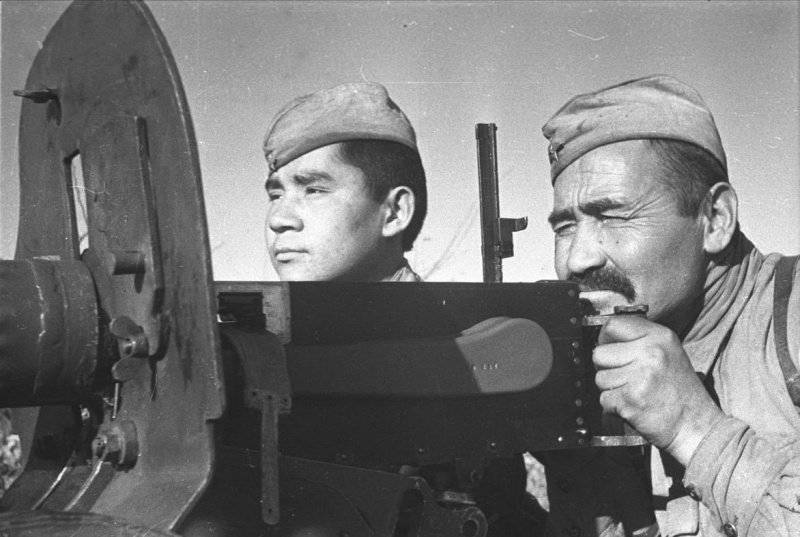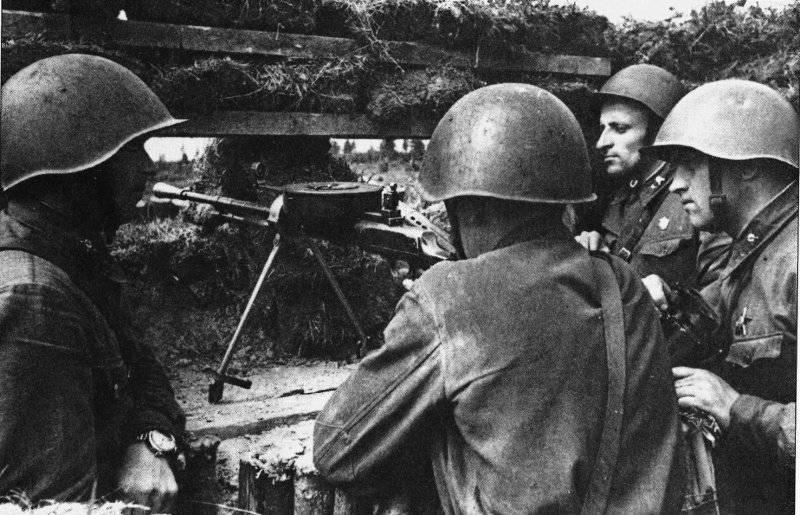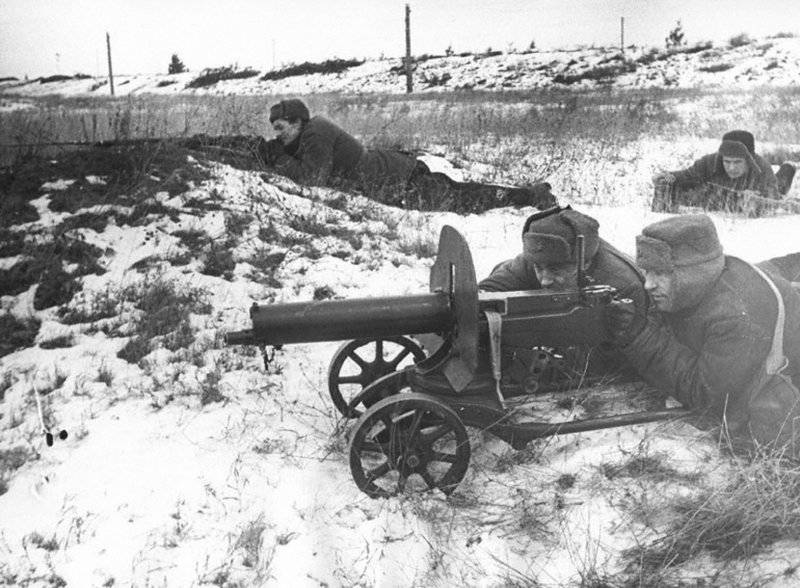Machine gun armament of the Red Army
At the end of the First World War, the question of the importance of light machine guns in the infantry weapons system became a priority. In this regard, during the 20-s of the last century, a large number of their variants were created in different countries. To reduce the weight and speed up the reloading, we used air-cooled barrel systems and magazines that had 20 - 50 cartridges capacity. If at the end of World War I the average weight of a light machine gun was 11,5 kilogram, then in the middle of 30-ies this figure was already 8,5 kilogram.
Light machine guns were finally transferred to the category of individual weapons, along with machine guns and machine guns. At the same time, light tripod machines were created for light machine guns to replace machine guns, although they could make a single machine gun that would be effective as a machine gun, hand gun, anti-aircraft gun and tank only in Germany - the MG.34 machine gun became them. In the armies of many countries in respect of machine guns were satisfied with the "veterans", used in the First World War. Here, the main changes were mainly installations and sights. With the help of machine guns, the battalion’s areas of action were to overlap with fire, which was a decisive requirement for the firing range. It was believed that when using riflescopes and quadrants, these machine guns could fire indirect and semi-direct fire at a range from 5 to 7 thousand meters. Considerable attention was paid to the use of machine guns in the air defense system, so in the 20-e - 30-e there was a rapid development of universal machine tools, anti-aircraft machine-gun installations and sights. However, work was also being done on lightweight machine-guns (Italy, USSR).
Important changes were observed in the families of rifle and machine-gun cartridges. For effective machine-gun fire at considerable distances, a heavy (“long-range”) bullet was required, and the rapid development of military equipment increased the importance of special bullets. In the USSR, for example, in addition to a heavy bullet, an incendiary, sighting and incendiary, armor-piercing, tracer, armor-piercing-tracer, armor-piercing incendiary was adopted. The transition of the Japanese and Italian armies from the caliber 6,5 mm to the caliber 7,7-8 mm is characteristic. It would seem that this transition was unprofitable from the point of view of flatness of trajectories and weight of ammunition, but it was caused by the need to increase the power of machine-gun fire at considerable distances and the difficulty of making special bullets in small calibers.
The development of heavy machine guns was more intense - it was spurred by the development of armored vehicles and combat aviation. In the process, two directions emerged - 12,7 - 14,5 mm machine guns and 20 - 25 mm automatic guns close to them. Regarding installations, a large number of different solutions have also been encountered.

The First World War showed the importance of the volume and scale of weapons production, but this experience was perceived differently. If, for example, in Great Britain and France, the rather isolated position of firms engaged in the production of weapons (it was carried out on special equipment with extensive use of highly skilled manual labor) was maintained, then in Germany and the USSR a unified system of standards and normals was introduced, in weapons production they switched to using non-deficient materials and standard machine tools. Here it should be noted the close relationship of military-technical works in Weimar Germany and in the USSR in the 1920 and the beginning of the 1930. In both countries, they wanted to centralize the management of the creation and production of weapons. In place of the empirical method came the method of experimental design and scientific research. There was a close interaction of customers, researchers, developers, manufacturers and users. Gradually, the idea of unifying automatic weapons was approved.
In the weapons system of various countries in the second half of the 1930-ies there have been significant changes. These changes have not bypassed machine-gun technology. In the USSR, this was reflected in the creation of new large-caliber and easel machine guns. True, the reliability of the DS, which was put into service at the beginning of the Second World War, turned out to be insufficient. A significant role was played by the reduction of development work carried out, time constraints and changing requirements.
It should be noted that the Soviet leadership was aware of the good equipment of a potential enemy automatic weapons. From 39 to the middle of 41, the number of machine guns in the Red Army increased by 29%, manual - by 44%. The plan for 1941 for the year included the production of 3 thousand machine gun Maxim, 39 thousand DT and DP, 4 thousand DShK.
The divisions consisted of light machine guns, the composition of machine-gun companies, platoons and divisions - easel.
The Soviet-Finnish war (1939-1940) showed the need to saturate the units with machine-gun technology and to supplement its fire with machine-pistols on the one hand and mortars on the other.
The last pre-war state (April 1941 of the year) provided for the following ratio of machine and light machine guns:
- The personnel of the wartime rifle division was 14483 man, armed with 174 machine guns and 392 light machine guns;
- the personnel of the reduced-strength division was 5864 man, armed with 163 machine guns and 324 light machine guns;
- The personnel of the mountain rifle division was 8829 man, armed with 110 heavy machine guns and 314 light machine guns.
For example, in June 1941, in the Kiev Special Military District, the Fifth Army's rifle formations were equipped with machine guns on average 117,8% of the state, light machine guns - 114,5%, Sixth Army - 128 and 110%, respectively, of the Twelfth Army - 103 and 100%, the twenty-sixth army - 118 and 112%. Mountain rifle divisions had 126% of the assigned easel machine guns and 103% of manual ones. But the number of submachine guns in the divisions of the above armies ranged from 0 to 35% of the state. To combat air targets, the staff of the rifle regiment had a company with six 7,62 mm and three 12,7 mm four machine guns, another 6 units were part of the artillery division. The cavalry regiment included three units. In fact, the number of anti-aircraft machine guns was approximately eleven per infantry division (in addition, in the machine-gun company of the infantry battalion there should have been one anti-aircraft tripod) and six per tank or motorized division. For example, in the Fifth Army, the number of anti-aircraft machine-gun mounts in divisions averaged 6% of the state. The air defense corps (such corps provided cover for Moscow, Leningrad, Baku) was to have 231–236 heavy machine guns, the air defense brigade — 27, the air defense regiment — 18 machine guns. Air defense forces on June 21, 1941 had only 61% of the state machine guns. So the case with anti-aircraft machine guns was the worst.
The number of automatic weapons in the rifle divisions of the Workers 'and Peasants' Red Army (14483 personnel) and Wehrmacht infantry divisions (1685 personnel) at the beginning of 1941, was:
- submachine guns - 1204 and 767 units. respectively (83 and 45,5 on 1000 people);
- light machine guns - 392 and 495 units. (27 and 29,4 to 1000 people);
- machine gun - 174 and 118 units. (12 and 7 on 1000 man);
- anti-aircraft machine gun installations (including large-caliber) - 33 units. in the Red Army, in the infantry divisions of the Wehrmacht were absent.
Machine guns were in service with machine-gun battalions, artillery and machine-gun battalions and mouths of fortified areas. But in most cases fortifications were not completed, were kept with incomplete armament and with significantly reduced staff.
An DT tank machine gun - the Directive of the General Staff from 16 in May 1941, the 50 of the newly formed tank regiments of mechanized corps to tank manning and anti-tank guns for 80 for self-defense - received an interesting application.

It is not in vain that the Second World War is often called the “war of industry” or the “war of factories.” The Second World War became a confrontation between the mature and highly developed industry of Germany and the states subordinate to it, with the young industry of the USSR. Even before the start of the war, modern weapons factories of Czechoslovakia and Austria (Germany’s industry ranked second after the US) were fully operational in Germany, not to mention the help of other “neutral” states, and the occupation of France, Holland, Belgium, Norway, Poland gave the Third Reich considerable stocks of raw materials, greatly expanded the production of steel and iron. The system of mobilization and management of German industry, even despite its bulkiness, acted very effectively. But the armies of Italy, Hungary, Finland, Romania, which also had their own weapons and industry, still acted against the Soviet Union.
The pre-war industry of the USSR could not fully equip the troops with the necessary weapons. For example, the air defense equipment of the USSR with anti-aircraft machine gun installations on 22.06.1941 was as follows:
The northern air defense zone according to the state was supposed to have 258 anti-aircraft machine gun installations, but it had only 155 or 60% staffing;
The North-Western air defense zone was staffed by 100% statewide and had 69 anti-aircraft machine guns;
The western air defense zone according to the state should have 225 anti-aircraft machine-gun systems, but it had only 122 or 54% staffing;
The Kiev air defense zone according to the state should have 240 anti-aircraft machine-gun systems, but it had only 178 or 74% staffing;
The southern air defense zone was staffed by 100% statewide and had 118 anti-aircraft machine guns;
In total, the state of the 1 should have been 910 anti-aircraft machine gun installations, but there was only 642 or 70,5% staffing.
An even more deplorable situation was observed in the 2 line where:
The Moscow air defense zone according to the state should have 238 anti-aircraft machine-gun systems, but had only 105 or 44% staffing;
The Oryol air defense zone according to the state should have 32 anti-aircraft machine-gun installations, but had only 6 or 19% staffing;
The Kharkiv air defense zone according to the state should have 57 anti-aircraft machine-gun systems, but had only 4 or 7% staffing;
That is, the state of the 2 should have been 327 anti-aircraft machine gun installations, but there was only 115 or 35% staffing.
These figures show that the air defense of the USSR on the 22.06.1941 year was equipped with anti-aircraft machine gun installations of all 61%.
The catastrophic development of events for the USSR in 1941 and in the beginning of 1942, the huge losses in armaments and manpower raised the question not only about increasing the output of weapons and replenishing the losses, but actually about arming and forming a new army. During the first three months of the war, the production of machine guns increased 2 times, and large-caliber - 5 times. However, with the loss of the south of Ukraine and the Donbass this growth has declined sharply.
Nevertheless, despite the loss of a significant part of resources, capacities and qualified personnel, the rush evacuation of some factories and the same rush reorientation of some industries to the production of weapons, the industry managed to provide most of the weapons needs. A significant role was played by the rapid growth rates, the training of engineering and technical personnel, the organization of the production of specials. steel, standardization of production, as well as the groundwork in the field of new mass production technologies - dornirovany, cold stamping, spot welding.
Weapon production is one of the most metal-intensive, therefore, forging plants and forging production and its own metallurgy developed. The mobilization readiness of weapons and artillery factories ensured not only the build-up of its own production in war conditions, but also the mobilization of civilian factories. If in the 1942 year, the total steel output was 44,3% of the 40 level of the year, then in the People's Commissariat of Weapons this figure was 89%, and in the 44 year - 95,5%.
In small arms, the role of the Lend-Lease was small. If Lend-Lease delivered about 131 thousand machine guns, then in the Soviet Union only 1942 in the year they were released 356,1 thousand. However, a certain number of machine guns arrived with samples of armored weapons and equipment, ships and aircraft.
However, in the second half of 41, the problem of armament was extremely acute, it was necessary to reduce the saturation of troops with automatic weapons. Therefore, old foreign machine guns were used (for example, near Moscow in the divisions of the people's militia and the Red Army were the old Lewis, the Polish trophy Browns, the German MG.08), but they lacked ammunition and did not have time to master them. But on the other hand, during the fighting, even in the presence of their own machine guns, the German MG.34 and MG.42 were willing to use in sufficient quantities. Although the captured machine guns were supposed to be transferred to trophy teams, the commanders, in the event of the presence of ammunition, replenished their arsenals with their own units.
In the second half of 42, the output of machine guns began to grow again, reaching 41,1 thousand in October. To increase the volume, it was necessary to reduce the requirements for finishing - for example, finishing of exterior parts and parts that did not participate in the automation was abolished. But the technological documentation on small arms was carried out “by letter B”, that is, it demanded compliance with standards, did not allow changes in form, materials of parts and sizes at all plants. For the entire 43 year, 458,5 thousand machine guns were released (or 127% from the previous year), for 44 year - 439 thousand (the number of orders decreased due to the saturation of troops with automatic weapons). It should be noted the sharp increase in the number of heavy machine guns in 43-44, as well as the doubling of the number of heavy machine guns and light machine guns in 43 year and their saturation of parts. Do not forget about the increase in the number of armored vehicles - in the Red Army on 1 in January 1945, there were more than 50 thousand tank machine guns.
Total for the period from 1941 to 1945. Arms of the People's Commissariat of Weapons produced 1 515 900 machine guns of all types (1 048 500 machine guns were produced in Germany in the same period). The scale of the use of machine guns can be judged by the following figures. In July-November 42, the GAU transferred the 5302 machine gun to the fronts of the south-west direction. During the preparation of the Kursk battle in March-July 1943, the troops of the Central, Steppe, Voronezh fronts and the Eleventh Army received 31,6 thousand light and heavy machine guns. The troops who launched an offensive near Kursk had 60,7 thousand machine guns. Characteristic is the average percentage of losses - for the entire war on heavy machine guns it was 45,3% (in 1941-m - 64,6% and in 1945-m - 6,6%), light machine guns - 51,3% (64,6% and 6,6%, respectively).
The need for ammunition grew rapidly, especially since a significant part of the reserves was lost in the first months of hostilities. In 1942, the release of cartridges equaled 136% of the production volume of 1940, and in 1945, this figure was already 224%. If 41 4 336 million rounds of all types of cartridges were released in 44, then 7 406 million were released in 201 year. According to the GAU, during the Stalingrad battle (500 day) 390 millions of rounds were spent, as many for the Battle of Kursk, and during the Berlin operation XNUMX millions. Much of the expense accounted for precisely on machine guns.

Information